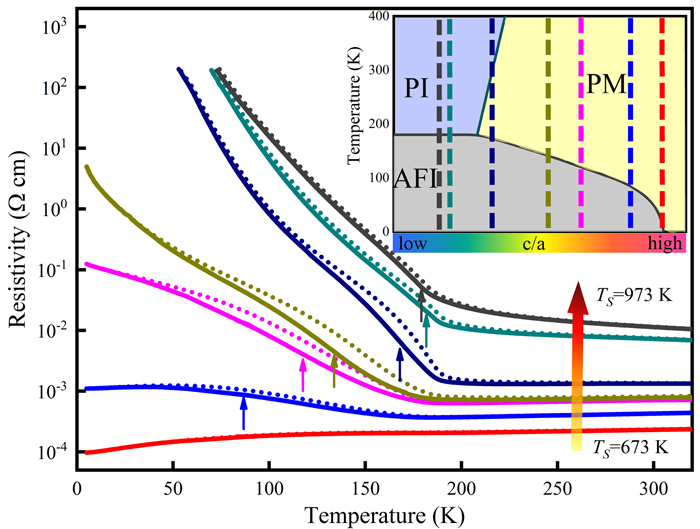
As an archetypical correlated oxide which possesses rich metal-insulator transitions, V2O3 has been extensively studied. The paramagnetic metallic (PM) phase can evolve into a paramagnetic insulating (PI) phase or an antiferromagnetic insulating (AFI) phase. However, it is still controversial that the PM-PI transition is caused by electron correlation/trigonal distortion or Cr-doping induced local structure distortion/disorder. In addition, the basic physics behind PM phase and PM-AFI transition remains unclear.
Recently, researchers led by Prof. ZHU Xuebin from the Institute of Solid State Physics, Hefei Institutes of Physical Science (HFIPS) unveil the mechanisms of metal-insulators in V2O3 from the viewpoint of trigonal distortion. The research, which was published in Physical Review B, formed the new basis for elucidating the leading source of PM-PI transition and understanding the PM phase and PM-AFI transition.
"We used substrate temperature during deposition as the only tunable parameter,” said HU Ling, who conducted the research, “due to the large differences of lattice and thermal expansion coefficient between V2O3 and Al2O3.”
To their excitement, the PM-PI transition was successfully reproduced in pure V2O3 thin films through enhancing trigonal distortion.
"We studied the electrical transport properties and Raman spectra,” said HU, "and found that in-plane tensile strain in film and Cr doping in V2O3 single crystal played the same role in triggering PM-PI transition."
On one hand, this result provided key experimental evidence that the enhancement of trigonal distortion would be the leading source for the appearance of the PI phase and PM-PI transition in (V1-xCrx)2O3, whereas the structural inhomogeneity induced by Cr doping contributes to the higher resistivity of both PM and PI phases. On the other, the a1g orbital occupation gauged by the A1g phonon mode in the PM phase strongly varies with the trigonal distortion, which determined the PM-AFI transition characteristics.
Thus the team concluded that the PM phase cannot be taken for granted to exhibit identical orbital occupations.
This research revealed that the strain in the films would modulate trigonal distortion in a different way from chemical doping and hydrostatic pressure in V2O3 single crystals.
This work was supported by National Key R&D Program of China and National Natural Science Foundation of China.
Unveiling the mechanisms of metal-insulator transitions in V2O3: The role of trigonal distortion

Temperature-dependent resistivity of the V2O3 thin films with different c/a ratios (Image by HU Ling)
Contact:
ZHAO Weiwei
Hefei Institutes of Physical Science (http://english.hf.cas.cn/)
Email: annyzhao@ipp.ac.cn